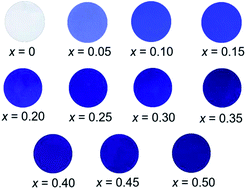Synthesis and characterisation of Ba(Zn1−xCox)2Si2O7 (0 ≤ x ≤ 0.50) for blue-violet inorganic pigments
Abstract
Ba(Zn1−xCox)2Si2O7 (0 ≤ x ≤ 0.50) solid solutions were synthesized as novel blue-violet inorganic pigments by a conventional solid-state reaction method. The crystal structure, optical properties, and colour of the pigments were characterized. All the pigments were obtained in a single-phase form. The pigments strongly absorbed visible light at wavelengths from 550 to 650 nm, corresponding to the range of green to orange light. This optical absorption was caused by the d–d transition of the tetrahedrally coordinated Co2+ (4A2(F) → 4T1(P)), which was the origin of the blue-violet colour of the pigments. The most intense colour was obtained for Ba(Zn0.85Co0.15)2Si2O7, where a* = +52.2 and b* = −65.5 in the CIE (Commission Internationale de l'Éclairage) L*a*b* system. These absolute values were significantly larger than those of commercial violet pigments such as Co3(PO4)2 (a* = +33 and b* = −32) and NH4MnP2O7 (a* = +39 and b* = −21). Therefore, the Ba(Zn0.85Co0.15)2Si2O7 pigment could be a novel blue-violet inorganic pigment.



 Please wait while we load your content...
Please wait while we load your content...